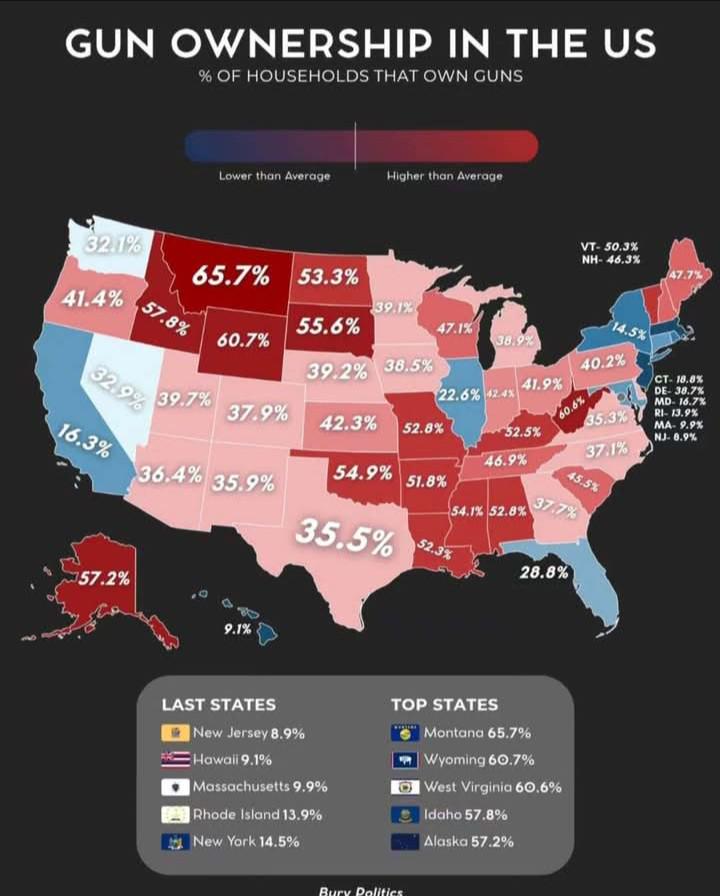Gun Ownership Per Household in the US Map


Alex Cartwright
Senior Cartographer & GIS Specialist
Alex Cartwright is a renowned cartographer and geographic information systems specialist with over 15 years of experience in spatial analysis and data...
Geographic Analysis
What This Map Shows
The visualization titled 'Rate of Gun Ownership per Household in the US' provides a clear representation of the percentage of households in each state that own firearms. This map highlights significant regional disparities, particularly noting the high rates of gun ownership in Southern and Western states, alongside a special mention of Vermont, which often stands out for its unique relationship with firearms. Understanding these patterns is crucial for examining cultural attitudes towards gun ownership across the nation.
Deep Dive into Gun Ownership in the US
Gun ownership in the United States is a complex and multifaceted issue, deeply intertwined with the country's history, culture, and legal framework. According to various surveys and studies, approximately 30% to 40% of American households report owning at least one firearm. However, this average masks significant variations across different states and regions.
Interestingly, the Southern states, such as Alabama, Arkansas, and Mississippi, consistently show some of the highest rates of gun ownership. For instance, Mississippi reports that over 50% of its households own guns. This can be attributed to several factors, including cultural traditions that emphasize hunting and self-defense. In many Southern communities, firearms are seen not only as tools for sport but also as symbols of personal liberty and heritage.
In the Western states, particularly Wyoming and Montana, gun ownership rates are similarly high. These states often feature vast rural areas where hunting and outdoor activities are prevalent, creating a natural inclination towards firearm possession. Moreover, the rugged landscapes and lower population densities contribute to a sense of self-reliance, which many residents believe necessitates having a firearm for personal safety or wildlife encounters.
On the other hand, the state of Vermont stands out as a unique case. With one of the highest rates of gun ownership in the country, Vermont has a rich tradition of responsible gun ownership. Interestingly, the state has relatively lenient gun laws, which allows residents to carry firearms openly without a permit. This has contributed to a culture where gun ownership is normalized and often seen as a rite of passage for young Vermonters. The state's low crime rate also plays a role, as many residents perceive less need for restrictive gun regulations.
However, the relationship between gun ownership and crime rates is complex. Research has shown that higher rates of gun ownership do not necessarily correlate with increased violence; in fact, some regions with high ownership rates also report low crime levels. This dichotomy raises questions about the effectiveness of gun control policies and their impact on public safety.
Regional Analysis
When we break down the map by regions, the disparities in gun ownership become even more pronounced. In the Northeast, states like New York and Massachusetts have significantly lower rates of gun ownership compared to their Southern counterparts. This can be attributed to stricter gun laws and a cultural attitude that often views gun ownership with skepticism.
In the Midwest, states like Indiana and Missouri are also notable for their higher rates of gun ownership, aligning more with the Southern philosophy of self-defense and hunting. However, there’s a notable contrast in urban areas where gun ownership rates tend to drop significantly. For example, in Chicago, strict gun control measures have led to a much lower prevalence of firearms in households.
Interestingly, California presents a mixed picture. While it has stringent gun laws, there are still significant pockets of high ownership, particularly in rural areas. This reflects a broader trend where urban areas tend to support stricter regulations, while rural areas advocate for gun rights.
Significance and Impact
The topic of gun ownership in the United States is not only relevant for understanding cultural attitudes but also holds significant implications for policy-making. As debates surrounding gun control continue to be a hot-button issue, this map serves as a crucial tool for lawmakers and advocates alike. Understanding where gun ownership is most prevalent can help shape legislation that considers the unique needs and values of different communities.
Moreover, current trends indicate that gun ownership may be on the rise, especially in light of recent events that have sparked debates on personal safety and self-defense. As more individuals consider firearms as a means of protection, the dynamics of gun ownership in the US will likely evolve, prompting further discussions on regulations and safety measures.
In conclusion, the 'Rate of Gun Ownership per Household in the US' map not only illustrates where firearms are most prevalent but also invites a broader conversation about the implications of gun culture in America. As we look to the future, understanding these dynamics will be essential for fostering informed discussions around gun ownership and public safety.
Visualization Details
- Published
- October 3, 2025
- Views
- 50
Comments
Loading comments...